Chapter 12 Surveys in the United Kingdom and United States show that black people of African or African-Caribbean origin have higher levels of blood pressure and a greater prevalence of hypertension than white Caucasians. This greater burden of hypertension is associated with higher rates of renal failure, left ventricular hypertrophy and stroke. By contrast, morbidity and mortality from coronary heart disease is lower in black people than in the white population (Figure 12.1). Figure 12.1 Stroke and heart attack admission rates per 1000 admissions for all causes in European whites, South Asians and Afro-Caribbean blacks to Dudley Road Hospital, Birmingham, 1981–1986. Source: Reproduced with permission from Weil, J., Beevers, D.G. (1993) Cardiovascular disease in blacks, whites and Asians in Birmingham. In: Cardiovascular Disease: Risk Factors and Intervention (eds. N. Poulter, P. Sever, S. Thom), pp 63–70. Radcliffe Medical Press, Oxford. © Radcliffe Publishing. In general, there is little evidence that black patients consume more salt that other groups. Instead, they seem to be more sensitive to a given salt load than white patients, and advice on salt restriction is particularly important. Most salt intake (90%) derives from processed or ready-made foods rather than salt that is added at table or when cooking (10%), and education on restriction of salt intake should include expert dietary advice. There is evidence that African Americans consume significantly less potassium in fruit and vegetables than white Americans. The other striking difference between African origin people is that they have lower circulating plasma renin levels than all other groups (Figure 12.2). The reasons for this are uncertain but may be related to differences in renal sodium and water handling, reduced sympathetic nervous system activity and in some cases, possible early nephrosclerosis. From a practical point of view, those drugs that primarily act by blocking the renin-angiotensin-aldosterone system tend to be rather less effective in people with low plasma renin levels. Figure 12.2 Plasma renin activity in relation to age and ethnic origin in hypertensive patients. Source: Data from Freis, E.D., et al. (1983) American Journal of Medicine, 74, 1029–1041. If drug treatment is needed, black people trend to have different responses to antihypertensive drugs to white people and south Asian people. Blood pressure in black people responds better to thiazide or thiazide-like diuretics and to CCBs and poorly to β blockers, angiotensin converting enzyme (ACE) inhibitors, and angiotensin receptor blockers (ARBs) (Figure 12.3). In a comparison of the CCB, verapamil and the β blocker, metoprolol in African-Caribbean patients with diabetes, metoprolol was no more effective than placebo but verapamil significantly reduced blood pressure. These trends explain the recommendations of the UK BHS/NICE guidance on the choice of first-, second- and third-line antihypertensive therapy in African-origin versus European-origin patients (see Chapter 9). Figure 12.3 Differences in the response of systolic blood pressure to the major classes of antihypertensive drugs in relation to ethnic origin. Source: Data from Wu, J., et al. (2005) American Journal of Hypertension, 18, 935–942. These ethnic differences in response to antihypertensive treatment have significant implications for prognosis – for example, among the black (but not white) patients with hypertension in the Antihypertensive and Lipid Lowering treatment to prevent Heart Attack Trial (ALLHAT) study, stroke and coronary events were significantly more common among patients randomised to an ACE inhibitor than those randomised to chlortalidone. No differences in these end points were seen between those randomised to the thiazide or thiazide-like diuretics and those randomised to the dihydropyridine CCB amlodipine. These differences in outcome are largely explained by the fact that CCBs and thiazides are more effective at controlling blood pressure than ACE inhibitors. The combination of diuretic treatment with ACE inhibitors, however, is as effective in black people as in white people. Alternatively, very high doses of β blockers or ACE inhibitors (or ARBs) are needed to achieve the same degree of reduction in blood pressure. Nonetheless, in patients with renal impairment, an ACE inhibitor is still needed. For example, the African-American Study of Kidney Disease and Hypertension trial in African-American patients with renal impairment compared the ACE ramipril with amlodipine and with the β blocker metoprolol. The trial was stopped prematurely because of worsening of renal failure in those randomised to amlodipine but not ramipril. Patients of South Asian origin with hypertension are at very high risk from coronary heart disease and diabetes mellitus. In the United Kingdom, this population has higher mean levels of blood pressure and a higher prevalence of hypertension than the white population, as well as a higher risk of stroke. Sadly, no morbidity or mortality data from hypertension trials that relate to this population are available. In addition, no robust data are available to suggest that South Asian people respond differently to antihypertensive agents than white Caucasians. The thiazide diuretics, which can worsen glucose intolerance, should therefore be used with some caution. In people from the Far East, some epidemiological and clinical trial data are available. Of note, mean levels of blood pressure in Chinese people in the United Kingdom may be higher than those of people in mainland China. There is insufficient information on the effects of antihypertensive drugs in South Asian and Chinese-origin patients. What little evidence there is suggests that drug response in these groups is similar to European-origin patients. Coronary heart disease and stroke are the major causes of mortality in elderly people, and hypertension is the most common treatable risk factor. A definition of ≥160/95 mm Hg means that more than half of the 12 million people in the United Kingdom older than 60 years are hypertensive. With a definition of ≥140/90 mm Hg, more than 70% of people will be hypertensive. In this patient group, isolated systolic hypertension is common, and, on an epidemiological basis, the degree of systolic hypertension is related more closely to stroke and coronary heart disease, even when underlying diastolic blood pressure is corrected for. An age-related increase in pulse pressure is also seen. Multiple measurements of blood pressure should be taken in elderly people to confirm the diagnosis of hypertension, as such patients tend to have greater variability in blood pressure. During the initial assessment, attention to symptoms and total cardiovascular risk should be checked. In addition, measurements of blood pressure with the patient in the seated and standing positions are needed to assess postural or orthostatic hypotension, which is more common in older people. If the latter is significant (e.g., a decrease in systolic blood pressure with standing of ≥20 mm Hg with symptoms), antihypertensive treatment should be titrated to standing values of blood pressure. Ambulatory blood pressure measurement may be of particular value in identifying patterns of 24-h blood pressure behaviour in the elderly (see Chapter 4). All elderly people with hypertension should be given lifestyle advice. In particular, a diet low in salt is more effective in elderly people than in younger patients. Up until around 1985, there were few data on the value of reducing blood pressure in older patients. There was some anxiety that such treatment might do more harm than good with an excess risk of falls, hip fractures and hypotensive episodes. However, later, randomised trials were reassuring and it was demonstrated that the absolute benefits of antihypertensive treatment are much greater in elderly people with hypertension because of their increased absolute risk (Figure 12.4). Figure 12.4 Results of seven randomised controlled trials of antihypertensive therapy in elderly patients (Unpublished analysis of data from Australian National Blood Pressure Study, European Working Party on Hypertension in the Elderly, Coope and Warrender UK Trial, Systolic Hypertension in the Elderly Program, Swedish Trial in Old Persons, Medical Research Council (Elderly) and Systolic Europe) As shown in Figure 12.2, plasma renin levels fall with advancing age and as a result of this, drugs that block the renin-angiotensin system tend to be less effective in the elderly. In elderly patients, the CCBs are now the drugs of first choice, as they reduce cardiovascular morbidity and mortality. Should CCBs prove insufficient to control blood pressure, it is usual to add an ACE inhibitor or an ARB. As per the BHS/NICE guidance, thiazides and thiazide-like diuretics are now relegated to be third-line agents. β Blockers should now only be used in patients with concomitant heart disease. The hypertension in the very elderly trial (HYVET) has established the safety and efficacy of antihypertensive treatment in very elderly patients (Figure 12.5). In HYVET, 3845 elderly patients aged >80 years of age with a sustained systolic blood pressure of 160 mmHg or more were randomised to receive either the diuretic indapamide (sustained release, 1.5 mg) or matching placebo. The ACE inhibitor perindopril (2 or 4 mg), or matching placebo, was added if necessary to achieve the target blood pressure of 150/80 mm Hg. During the trial, the systolic blood pressure was 15 mm Hg lower in patients randomised to active treatment compared with those on matching placebo tablets. Figure 12.5 Principal results of the hypertension in the very elderly trial (HYVET). Source: Data from Beckett, N.S., et al. (2008) New England Journal of Medicine, 358, 1887–1898.
Ethnicity, age and hypertension
Ethnic groups
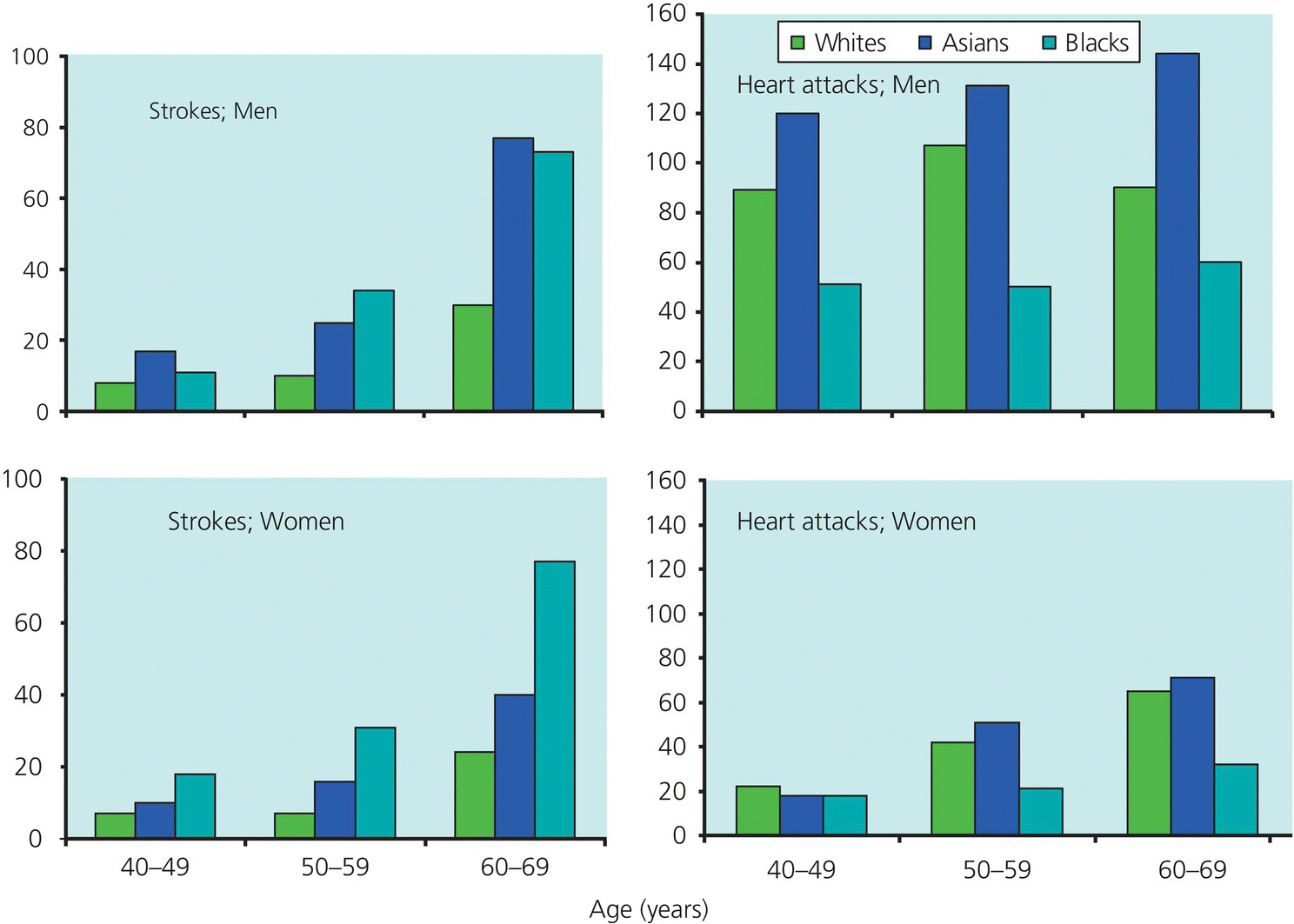
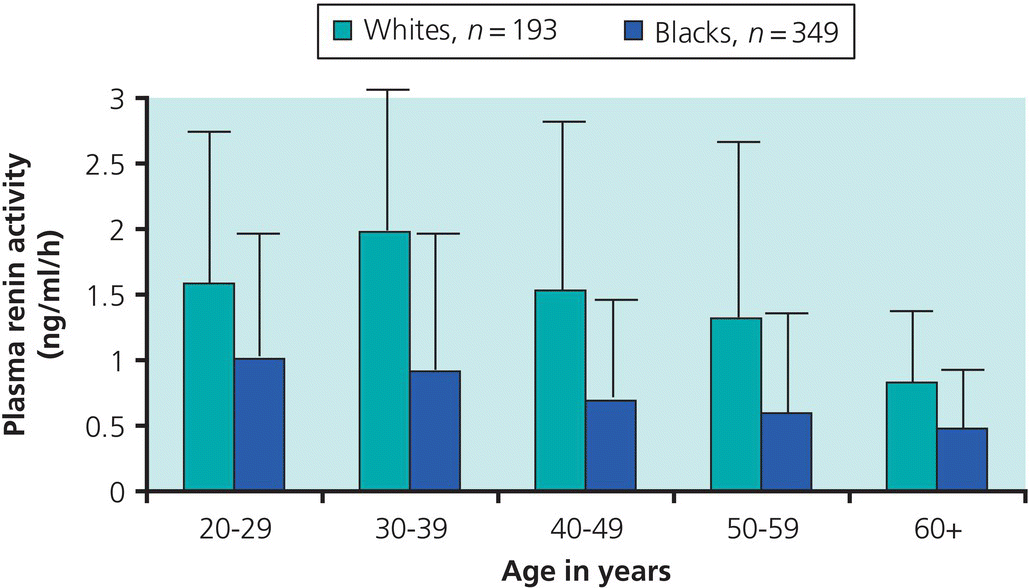
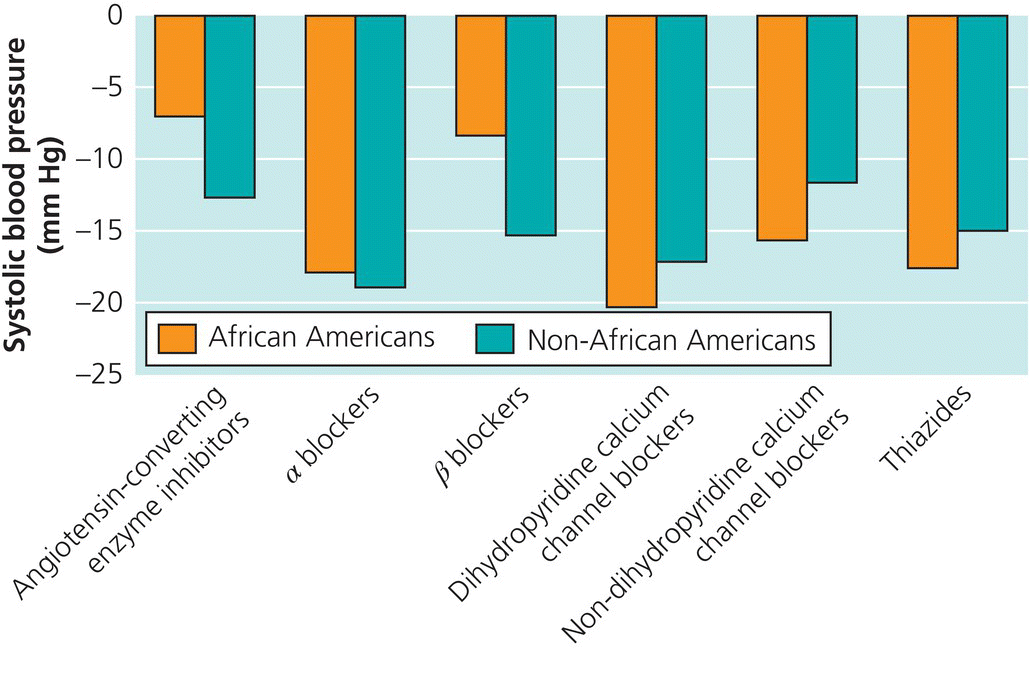
Elderly people
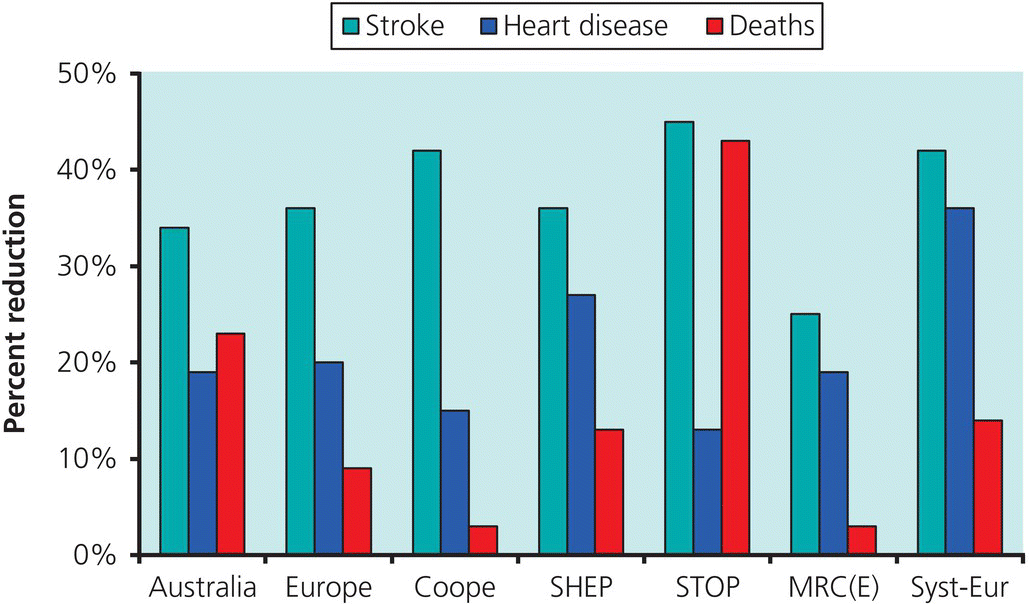
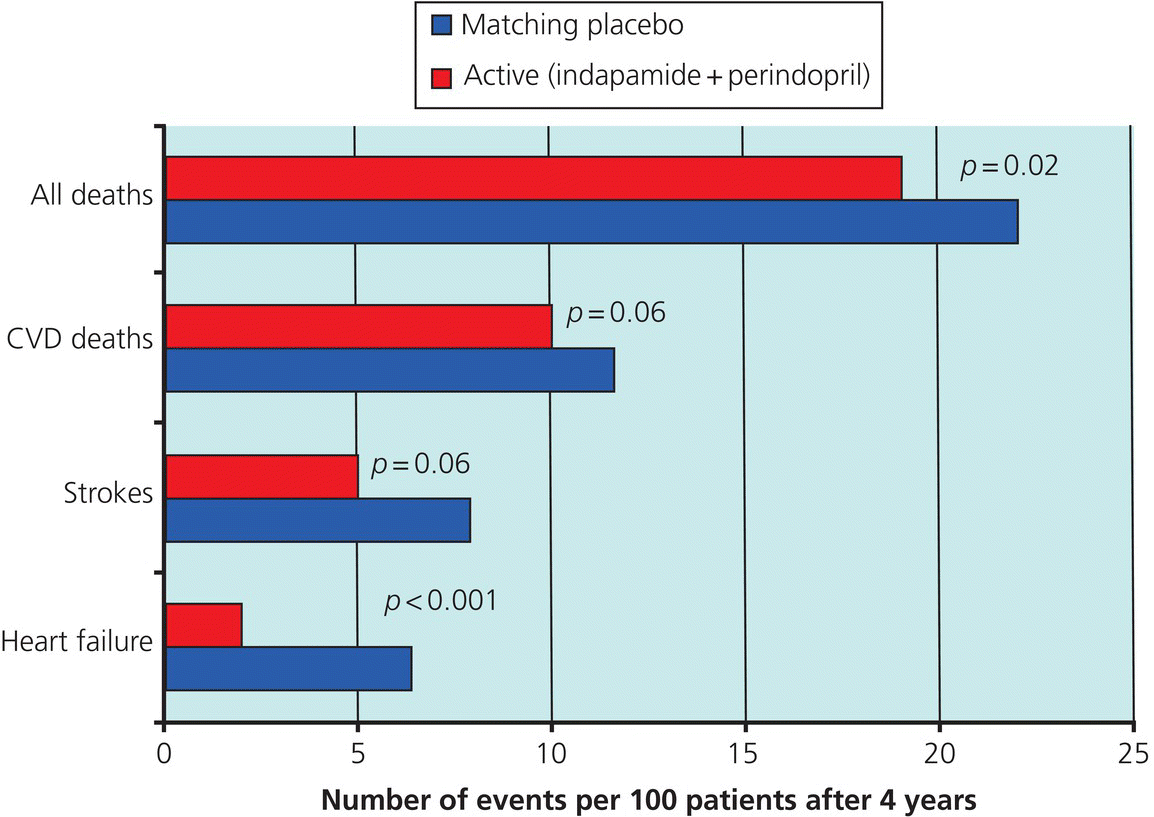
Ethnicity, age and hypertension
Only gold members can continue reading. Log In or Register to continue

Full access? Get Clinical Tree


